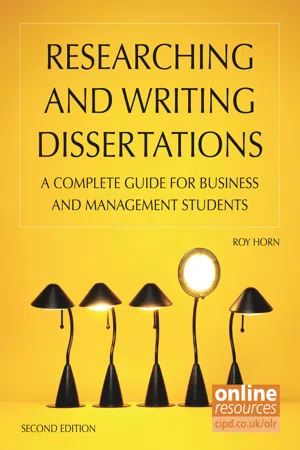![]()
CHAPTER 1
Preface and Introduction
•Why this book was written
•The readership level of the book and thus who can use it successfully
•The features of the book
•How to use different parts of the book for the different stages of your dissertation
•The general layout of the book
•To distinguish between quantitative and qualitative research
•Why dissertations are used to determine university degrees
•Which are the key skills that are assessed in a dissertation
•How your work is assessed
•What plagiarism is and how to avoid it
•The process by which you and your work are supervised
•Ten top tips for successfully completing on time
•The characteristics of excellent and of poor dissertations
1.1 INTRODUCTION
This preliminary chapter explains why this book was written and how the book can be used. A dissertation is put together in stages, and the chapter presents a guide to those parts of the book most useful for specific stages. The book includes many learning features, and these are outlined here too.
You are probably reading this book because you want to successfully complete your dissertation within a reasonable time frame while yet maintaining your sanity – there is a section in this chapter that features the ten top tips for completing on time. Other sections look at why dissertations are used to determine the university degrees that are awarded, at how your work is assessed, at the supervision process, and at the dangers of plagiarism. A further section introduces the nature of quantitative and qualitative research. There are in addition sections that explain how this book may be particularly useful for various specific courses.
Perhaps the best way to use this chapter is to read it through a couple of times. Try to establish how subsequent chapters may be most valuable to you, and match your reading of the book to the progressive production of your dissertation. Writing will be central to the successful completion of your dissertation, so I would advise an early look at Chapter 10 – The craft of writing. This will allow you to integrate these writing ideas into your work from an early stage.
1.2 WHY THIS BOOK WAS WRITTEN
I have supervised and assisted many undergraduate and postgraduate students as they carried out dissertation research and general research, and I wrote this book to help them. I hope it will help you. On a more personal note, I tend to find myself having to answer the same questions over and over again: the answers to all those questions are contained in this book. I have tried to make it as friendly and welcoming as possible so it may eventually seem like an old friend to be consulted when you are not sure of how to do something. Its limited size means that you might read it from cover to cover in a weekend – and you may wish to do this – but you will find it most useful if you read it in sections that are related to the stage of the dissertation you are completing.
The organisation of this book is based on the stages and the sequence of work that is required to complete a piece of research. You will therefore find that the first sections are about getting started and the research proposal. The sections in the middle are about methods and carrying out the research. Finally, the later sections are specific to writing and reviewing your work.
At my university we use the following dissertation stages:
•The proposal stage: around 1,000 words. This stage checks that you are proposing to write a dissertation on a viable topic and that you have identified a context, the appropriate literature and an appropriate method. The proposal as submitted is used to allocate a suitable supervisor.
•The extended synopsis stage: between 3,000 and 5,000 words. This stage ensures that you have a critical literature review and a well-reasoned and evaluated method.
•The final submission stage: between 12,000 and 20,000 words, depending on the degree award.
At the proposal stage I would advise reading the following chapters and sections:
Chapter 1 – Introduction
Chapter 2 – Finding a topic
Chapter 3 – The skills that are tested
Chapter 4 – The research proposal
Chapter 5 – Managing and completing on time
Skim read:
Chapter 6 – Theory and literature
Chapter 7 – Methodology
Chapter 10 – The craft of writing, and introductions and conclusions
The aim of the proposal stage is to develop and communicate to your supervisor your enthusiasm for a well-thought-out and do-able research topic.
At the extended synopsis stage, I would advise reading the following chapters and sections: Chapter 6 – Theory and literature
Chapter 7 – Methodology
Chapter 10 – The craft of writing, and introductions and conclusions
The aim of the extended synopsis stage is to ensure that your research is grounded in a critical debate of the literature and to guarantee that a well-reasoned and evaluated method is being followed.
At the point of data analysis, when you have collected data and may not be sure what to do with it, read:
Chapter 8 – Data and how to analyse it
Chapter 9 – Data analysis and representation
Remind yourself of:
Chapter 10 – The craft of writing introductions and conclusions
At the point of completing the research, read:
Chapter 11 – Reviewing and evaluating your dissertation
Remind yourself of:
Chapter 10 – The craft of writing, and introductions and conclusions Chapter 3 – The skills that are tested
Researching and Writing Dissertations has been designed and organised to be friendly and easy to use. Each chapter deals with a separate aspect of carrying out research. At the beginning of each chapter is an introduction beneath a bullet list of learning objectives that answer the question ‘What can I learn from this chapter?’ The m...
